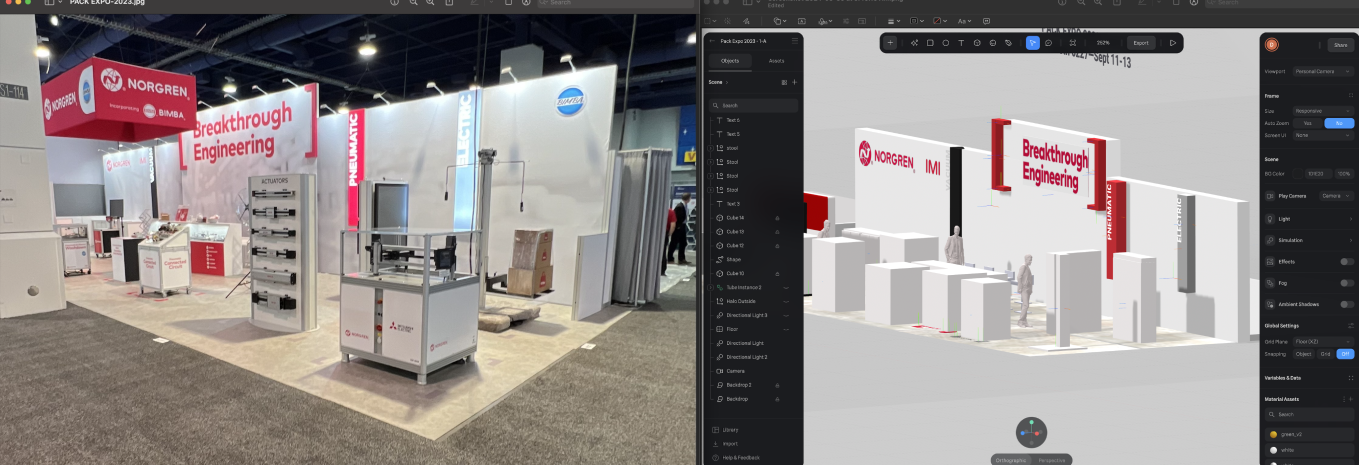If you’re going to make an impression at a trade show, you need a booth. Not only that, but you need a booth that is well-designed and welcoming to attendees. Getting a booth from concept to creation, though, takes a lot of planning and organization. We went behind the scenes with our trade show booth expert, Director of Production Services David Siegelman, to answer some questions about HDMZ’s process, advice, and more.
What is the most important element of planning a trade show booth?
It’s about setting a gameplan from the outset. First and foremost, we need to define who is responsible for which elements, and who has the authority to make decisions. We often work with a trade show vendor to build the booth, so it’s important to know what we’re handling and what they’re handling, as well as how involved the client wants to be. If there’s going to be swag or something special coming to the booth, such as an augmented reality experience, that means bringing in another vendor, and knowing who is going to manage that relationship. If there’s an issue with the booth, we need to know who is responsible for ensuring it gets fixed, and who has the authority to approve any decisions related to those potential issues.
Coordination is key when so many different parties are involved. One of the ways we facilitate that is by using a well-defined timeline and checklist. We typically develop a spreadsheet that we share with our client and vendors, and use it to make sure we’re hitting the various deadlines and that nothing is forgotten.
What are some common mistakes you see in trade show planning? What can people do to prevent those mistakes?
One major mistake to avoid is miscommunication — so again, outlining roles and responsibilities and accurate timelines is important. Another is failing to anticipate the unexpected challenges that will inevitably be thrown at you, such as literature that needs to be printed, or a new product that the client wants to showcase in the booth. You have to know how you’re going to handle situations like that. For example, you might identify a nearby FedEx location where you could have last-minute literature printed, or you might have printers on hand to handle last-minute signage requests.
Another mistake is not accounting for the modern process of graphic approval and printing. In the old days, you would get sections of booths printed and sent to you, and that’s not happening anymore. Everything is digital. That means that you might sign off and approve a graphic, then show up at the booth and find that everything is washed out. You have to find a vendor you can trust to reproduce exactly what you and the client have signed off on, and be able to find a solution when the graphics printed are not to your liking.
How do you visualize a booth before it’s built?
We use a web-based program, called Spline, for building designs in 3D. The program can create everything from a box design to a trade show environment. It puts the viewer on the trade show floor, and lets us visualize the booth from many different angles. That allows us to address questions such as, if a person is standing at a particular place, is that going to cover up critical content? We can also use it to guide decisions such as what furniture to rent, how to arrange assets to fit within the right dimensions, how many people to assign to a booth, or how to ensure easy movement for a booth visitor. Instead of a 2D rendering, the designers and clients can immerse themselves in a 3D environment to see what will or won’t work, which ultimately saves time and money.

What advice would you have for clients who want to make sure the process goes smoothly?
Set the ground rules and expectations up front. There are a lot of things that have to happen to take a vision for a booth and turn it into something ready for patrons to visit. If changes or additions are made too late in the process, there can be not only a cost to quality, but also to expense. So, establishing those expectations from the start is helpful for everyone.
It’s also great when a client is very engaged in the process. There are a lot of responsibilities on everybody’s part. So, when a client is 100% involved and responsive, that can really make a difference.
What makes a booth stand out?
I think simplicity is important. A lot of clutter, a lot of information, is just going to be overlooked or passed by. But a booth that ties sight and sound together to present a cohesive message stands out. The way the light effects are used — whether that’s overlighting, underlighting, backlighting or color — and the use of a strong, simple message can create a booth that draws people in.
What’s your favorite part of working on trade shows?
The part of the work I like most is when it’s all said and done, and we’re on the trade show floor and seeing the client happy. Or maybe seeing the response in real time, because everyone is always on social media talking about the show. For example, we created a swag station for one client where booth visitors could customize bags or shirts with patches they selected, and that turned out to be a huge success. They had a consistently long line and a great response, and that’s what makes it all worth it. Seeing the client happy makes me happy.



